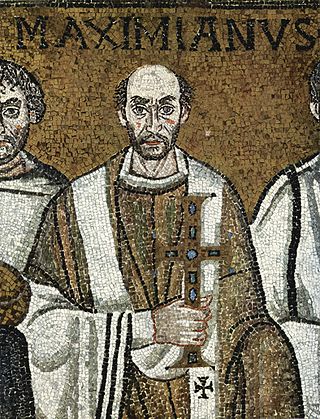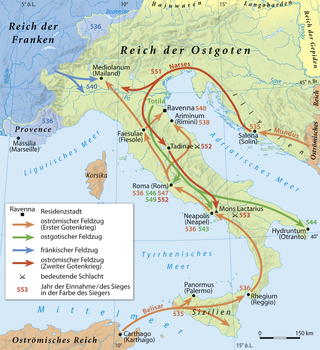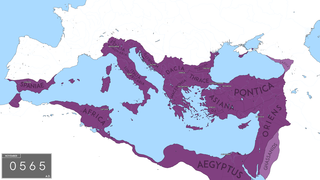Significant people
| | This section needs expansion. You can help by adding to it. (May 2019) |
| Millennium |
|---|
| 1st millennium |
| Centuries |
| Decades |
| Years |
| Categories |
The 540s decade ran from January 1, 540, to December 31, 549.
| | This section needs expansion. You can help by adding to it. (May 2019) |
540
541
542
543
544
545
547
548
549
540
541
542
543
544
545
546
547
548
549
The 530s decade ran from January 1, 530, to December 31, 539.
The 550s decade ran from January 1, 550, to December 31, 559.
The 560s decade ran from January 1, 560, to December 31, 569.

Year 540 (DXL) was a leap year starting on Sunday of the Julian calendar. In the Roman Empire, it was known as the Year of the Consulship of Iustinus without colleague. The denomination 540 for this year has been used since the early medieval period, when the Anno Domini calendar era became the prevalent method in Europe for naming years.

Year 546 (DXLVI) was a common year starting on Monday of the Julian calendar. The denomination 546 for this year has been used since the early medieval period, when the Anno Domini calendar era became the prevalent method in Europe for naming years.

Year 550 (DL) was a common year starting on Saturday of the Julian calendar. The denomination 550 for this year has been used since the early medieval period, when the Anno Domini calendar era became the prevalent method in Europe for naming years.

Year 552 (DLII) was a leap year starting on Monday of the Julian calendar. The denomination 552 for this year has been used since the early medieval period, when the Anno Domini calendar era became the prevalent method in Europe for naming years.

Year 535 (DXXXV) was a common year starting on Monday of the Julian calendar. At the time, it was known as the Year of the Consulship of Belisarius without colleague. The denomination 535 for this year has been used since the early medieval period, when the Anno Domini calendar era became the prevalent method in Europe for naming years.

Year 541 (DXLI) was a common year starting on Tuesday of the Julian calendar. In the Roman Empire, it was known as the Year of the Consulship of Basilius without colleague. Basilius was the last person to be officially appointed Roman consul, since after this year, the office was permanently merged with the office of Roman/Byzantine emperor. Thus, from the next year forward, the consular year dating was abandoned. The denomination 541 for this year has been used since the early medieval period, when the Anno Domini calendar era became the prevalent method in Europe for naming years.

Year 544 (DXLIV) was a leap year starting on Friday of the Julian calendar. The denomination 544 for this year has been used since the early medieval period, when the Anno Domini calendar era became the prevalent method in Europe for naming years.

Year 547 (DXLVII) was a common year starting on Tuesday of the Julian calendar. The denomination 547 for this year has been used since the early medieval period, when the Anno Domini calendar era became the prevalent method in Europe for naming years.

Year 549 (DXLIX) was a common year starting on Friday of the Julian calendar. The denomination 549 for this year has been used since the early medieval period, when the Anno Domini calendar era became the prevalent method in Europe for naming years.

Year 556 (DLVI) was a leap year starting on Saturday of the Julian calendar. The denomination 556 for this year has been used since the early medieval period, when the Anno Domini calendar era became the prevalent method in Europe for naming years.

Year 562 (DLXII) was a common year starting on Sunday of the Julian calendar. The denomination 562 for this year has been used since the early medieval period, when the Anno Domini calendar era became the prevalent method in Europe for naming years.

Totila, original name Baduila, was the penultimate King of the Ostrogoths, reigning from 541 to 552 AD. A skilled military and political leader, Totila reversed the tide of the Gothic War, recovering by 543 almost all the territories in Italy that the Eastern Roman Empire had captured from his Kingdom in 540.

Vitiges was king of Ostrogothic Italy from 536 to 540. He succeeded to the throne of Italy in the early stages of the Gothic War of 535–554, as Belisarius had quickly captured Sicily the previous year and was in southern Italy at the head of the forces of Justinian I, the Eastern Roman Emperor.

The Gothic War between the Byzantine Empire during the reign of Emperor Justinian I and the Ostrogothic Kingdom of Italy took place from 535 to 554 in the Italian Peninsula, Dalmatia, Sardinia, Sicily and Corsica. It was one of the last of the many Gothic Wars against the Roman Empire. The war had its roots in the ambition of the Byzantine emperor Justinian I to recover the provinces of the former Western Roman Empire, which the Romans had lost to invading barbarian tribes in the previous century, during the Migration Period.

The Byzantine Empire underwent a golden age under the Justinian dynasty, beginning in 518 AD with the accession of Justin I. Under the Justinian dynasty, particularly the reign of Justinian I, the empire reached its greatest territorial extent since the fall of its Western counterpart, reincorporating North Africa, southern Illyria, southern Spain, and Italy into the empire. The Justinian dynasty ended in 602 with the deposition of Maurice and the ascension of his successor, Phocas.
John, the nephew of the rebel Vitalian, was an Eastern Roman general under Justinian I, who was active in the Gothic War in Italy and against the Gepids in the western Balkans. He was married to Justina, the daughter of Justinian's cousin Germanus.
Bessas was an Eastern Roman general of Gothic origin from Thrace, primarily known for his career in the wars of Justinian I. He distinguished himself against the Sassanid Persians in the Iberian War and under the command of Belisarius in the Gothic War, but after Belisarius' departure from Italy he failed to confront the resurgent Goths and was largely responsible for the loss of Rome in 546. Returning east in disgrace, despite his advanced age he was appointed as commander in the Lazic War. There he redeemed himself with the recapture of Petra, but his subsequent idleness led Justinian to dismiss him and exile him to Abasgia.